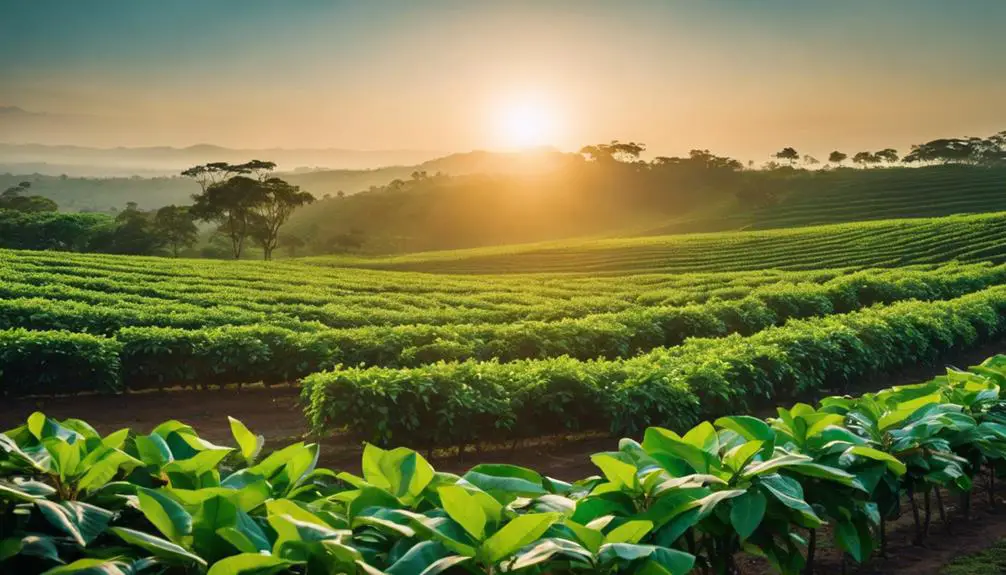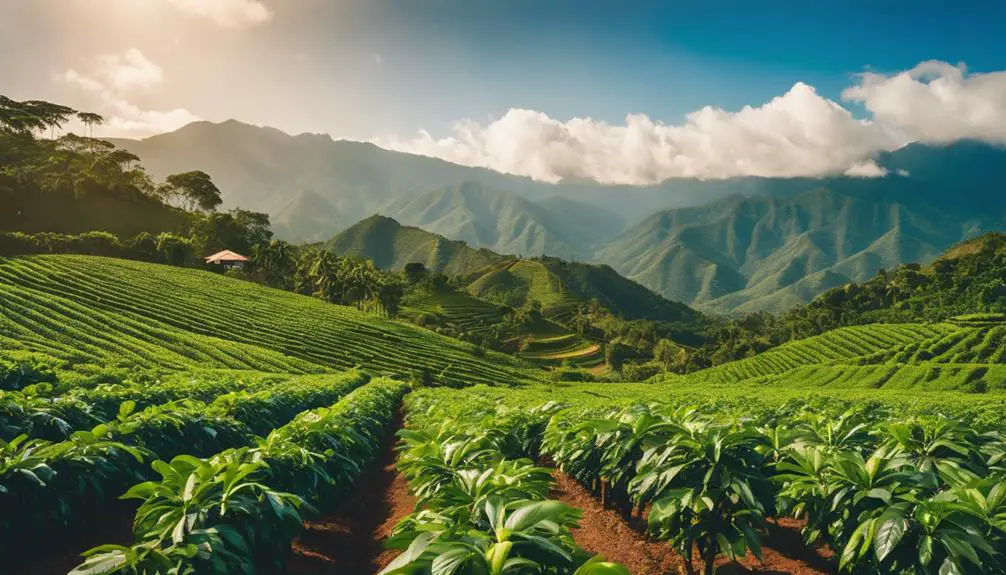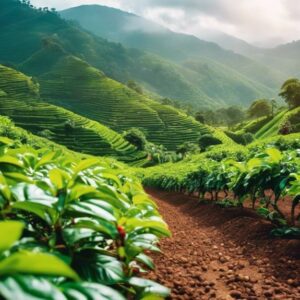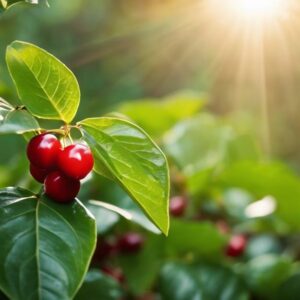Have you ever wondered which coffee variety stands above the rest, Colombian or Arabica?
The intricate flavors, subtle notes, and rich aromas of these two esteemed coffees have captivated connoisseurs for years.
But what sets them apart, and ultimately, which one will claim the title of supreme brew?
Find out as we unravel the complexities of Colombian and Arabica coffee, guiding you through a journey of taste and tradition that will redefine your morning ritual.
Colombian vs. Arabica: An Introduction

Let’s take a closer look at the world of coffee, focusing on the heart of the matter: Colombian vs. Arabica.
These key points will help you distinguish between the two popular varieties and understand their unique characteristics.
Get ready to explore the nuances that set Colombian and Arabica coffees apart.
Journey into the World of Coffee
Embark on a flavorful journey into the world of coffee, where the distinct characteristics of Colombian and Arabica beans await discovery. Coffee’s origin traces back to Ethiopia, where it was first cultivated.
The cultivation of these beans involves careful attention to altitude, with Colombian beans thriving in the high altitudes of the Andes Mountains, while Arabica beans flourish in various tropical regions worldwide.
Harvested by hand, these beans undergo meticulous processing to preserve their unique flavors. Colombian coffee, primarily Arabica, is known for its mild acidity and balanced body. On the other hand, Arabica, a species of coffee, offers a wide variety of flavors depending on its origin and processing methods.
Prepare to delve deeper into the rich world of coffee as we explore Colombian vs. Arabica further.
The Heart of the Matter: Colombian vs. Arabica
Entering the realm of Colombian vs. Arabica coffee unveils a captivating exploration of flavors and origins. Colombian coffee is renowned for its mild acidity and rich aroma, influenced by the high altitudes and fertile soil of Colombian plantations.
On the other hand, Arabica coffee, celebrated for its smooth taste and complex flavors, originates from diverse regions worldwide, each imparting unique characteristics to the beans.
Colombian coffee tends to offer a balance of nutty and fruity notes, while Arabica beans can showcase a wide range of flavors from floral to chocolaty undertones. Whether you prefer the tradition and consistency of Colombian coffee or the diversity and complexity of Arabica, the choice ultimately comes down to your personal palate preferences.
Arabica Coffee: The World’s Choice

When it comes to Arabica coffee, you’ll discover why it’s the world’s preferred choice. Its global popularity stems from its distinctive flavors and aromas that captivate coffee enthusiasts worldwide.
Understanding the science behind Arabica’s cultivation and characteristics sheds light on why it reigns supreme in the coffee industry.
The Arabica Advantage: A Global Overview
When exploring the Arabica advantage on a global scale, you’ll be amazed by the historical journey and diverse flavors this coffee offers. To get a glimpse of why Arabica reigns supreme, check out these key points:
- Arabica’s rich history in coffee culture
- The vast array of flavors found in Arabica beans
- Arabica’s dominance in the specialty coffee market
- The environmental impact of Arabica cultivation
- The economic significance of Arabica production
Historical Journey of Arabica Coffee
The historical journey of Arabica coffee unveils a rich tapestry of cultivation, trade, and cultural exchange that has shaped global coffee consumption.
Arabica, historically grown in diverse geographies, thrives in high-elevation regions with optimal conditions for farming. Its cultivation has influenced the coffee industry, making it one of the most sought-after crops worldwide.
Arabica’s historical significance continues to play a pivotal role in the world of coffee.
The Wide Spectrum of Arabica Flavors
Exploring the wide spectrum of flavors in Arabica coffee offers a sensory journey through the diverse and nuanced profiles that make it a global favorite.
- Beans: Arabica beans are known for their complex and varied flavor profiles.
- Roast: Different roasting techniques can bring out unique tastes in Arabica coffee.
- Taste: The taste of Arabica coffee can range from fruity and floral to nutty and chocolatey.
- Flavors: Arabica coffee boasts an array of flavors, making it a versatile choice for coffee enthusiasts.
- Spectrum: The spectrum of flavors in Arabica coffee caters to a wide range of preferences.
The Science of Arabica: Cultivation and Characteristics
You’re about to uncover the secrets behind Arabica coffee’s exceptional quality in terms of cultivation and characteristics.
Discover the exact conditions needed for Arabica to thrive and how processing and roasting play a crucial role in its unique flavor profile.
Get ready to explore the intricate science that makes Arabica the world’s preferred choice for coffee enthusiasts globally.
Optimal Conditions for Arabica Cultivation
When cultivating Arabica coffee, it is essential to create optimal conditions for its growth and development.
Arabica thrives in altitudes of 2,000-6,000 feet, with temperatures around 60-70°F. Adequate rainfall, well-drained soil, and shade are crucial for the bean’s quality.
Maintaining these conditions ensures a superior Arabica bean, favored for its exquisite flavor and aroma.
| Optimal Conditions for Arabica Cultivation |
|---|
| Altitude: 2,000-6,000 feet |
| Temperature: 60-70°F |
| Rainfall: Adequate |
| Soil: Well-drained |
The Art of Arabica: Processing and Roasting Techniques
To master the art of Arabica coffee, understanding the intricacies of processing and roasting techniques is essential.
- Processing Techniques: Innovative methods like honey processing to enhance flavors.
- Roasting Methods: Experimenting with different profiles to bring out unique characteristics.
- Arabica Varietals: Exploring diverse Arabica strains for richness.
- Body Enhancement: Utilizing specific techniques to enhance body and mouthfeel.
- Artistic Roasting: Embracing creativity in roasting for a distinctive brew.
Colombian Coffee: A National Treasure

Colombian coffee isn’t just a beverage; it’s a source of national pride. Its rich history and cultural significance make it more than just a drink.
The unique flavor and aroma of Colombian coffee have made it a beloved treasure both locally and internationally.
Unveiling Colombian Coffee: More Than a Name
You’re about to uncover the essence of Colombian coffee, a national treasure that goes beyond its name. Get ready to explore the unique climate of Colombia’s Coffee Belt and the global recognition Colombian coffee has gained in the industry.
Let’s kickstart this journey by understanding the crucial aspects that make Colombian coffee stand out:
- The ideal climate of the Coffee Belt
- Colombia’s prominent position in coffee production
- The worldwide recognition of Colombian coffee
- The significance of Colombian coffee on the international stage
- Unique characteristics of Colombian coffee beans
The Unique Climate of Colombia’s Coffee Belt
Nestled within Colombia’s picturesque landscape lies the unique climate of the country’s renowned Coffee Belt. The region’s high altitudes, ample rainfall, and cool temperatures create optimal conditions for cultivating high-quality coffee beans.
Check out the table below to discover more about the climate in Colombia’s Coffee Belt.
| Climate Factors | Description |
|---|---|
| Altitude | High altitudes provide… |
| Rainfall | Ample rainfall ensures… |
| Temperature | Cool temperatures contribute… |
| Biodiversity | Rich biodiversity… |
Colombian Coffee on the World Stage: Production and Recognition
Embarking on the global stage, Colombian coffee shines as a beacon of excellence in production and recognition.
- Colombian coffee production exceeds 11.5 million bags annually.
- Recognized for its exceptional quality and unique flavor profiles.
- Holds a prominent position in the competitive world coffee market.
- Gains increasing recognition for its sustainable farming practices.
- Colombian coffee continues to set new standards for excellence worldwide.
The Signature of Colombian Coffee: Flavor and Aroma
You’re about to explore the essence of Colombian coffee’s flavor and aroma, uncovering its unique terroir and taste that set it apart.
Discover how the processing methods from bean to cup play a crucial role in shaping the distinct flavors that Colombian coffee is renowned for.
Get ready to savor the rich and complex notes that make Colombian coffee a national treasure.
Terroir and Taste: Understanding Colombian Coffee’s Distinctiveness
Colombian coffee’s distinctiveness shines through its rich history, unique flavor profile, and the influence of its terroir on every sip. The terroir of Colombian coffee, with its ideal climate and altitude, plays a crucial role in shaping its exquisite taste.
Explore how the Colombian landscapes, from the Andes to the Caribbean coast, contribute to the diverse flavors found in each cup of this renowned coffee.
| Colombian Coffee Terroir | Flavor Profile |
|---|---|
| Andes Mountains | Citrus notes |
| Caribbean Coast | Cocoa undertones |
| Rainforest Regions | Nutty finish |
| Volcanic Soils | Floral aroma |
| High Altitude Farms | Bright acidity |
From Bean to Cup: Processing Methods Shaping Flavor
As you delve into the journey of Colombian coffee from bean to cup, the processing methods employed play a vital role in shaping the distinct flavor and aroma that characterize this national treasure.
- Wet-processed: Enhances brightness and acidity.
- Dry-processed: Adds complexity and body.
- Single-origin: Showcases unique terroir.
- Espresso: Intense and full-bodied.
- Blend: Combines different profiles for a balanced taste.
Side-by-Side: Colombian and Arabica Coffee Compared

Let’s compare Colombian and Arabica coffee side by side.
You’ll explore the chemical and flavor profiles beyond just the bean and delve into how their cultivation practices differ in terms of environmental and economic impacts.
This comparison will give you a nuanced understanding of these two renowned coffee varieties.
Beyond the Bean: Chemical and Flavor Profiles
When comparing Colombian and Arabica coffee, you’ll notice distinct differences in their chemical compositions and flavor profiles.
Below is a side-by-side comparison table highlighting the influence of altitude and climate on coffee taste as well as a comparative taste test to help you identify specific notes and nuances in each type of coffee.
| Points | Colombian Coffee | Arabica Coffee |
|---|---|---|
| Influence of Altitude and Climate | High altitudes and cooler climates in Colombia contribute to a balanced acidity and fruity flavors. | Arabica coffee’s preferred growing conditions include higher altitudes and mild temperatures, resulting in a more complex and nuanced flavor profile. |
| Comparative Taste Test | Colombian coffee tends to be brighter with a pronounced acidity and caramel sweetness. | Arabica coffee often exhibits a smoother, more floral profile with hints of chocolate and nutty undertones. |
The Influence of Altitude and Climate on Coffee Taste
Exploring the impact of altitude and climate on coffee taste reveals significant differences between Colombian and Arabica varieties. When it comes to coffee, altitude and climate play a crucial role in shaping the flavor profile.
Check out the table below for a quick comparison:
| Aspect | Colombian Coffee | Arabica Coffee |
|---|---|---|
| Altitude | High | Variable |
| Climate | Tropical | Diverse |
| Taste | Rich and Balanced | Smooth and Floral |
A Comparative Taste Test: Identifying Notes and Nuances
As we compare Colombian and Arabica coffees in a taste test, we delve into identifying their distinct notes and nuances, going beyond just the bean to explore their chemical and flavor profiles.
- Richness: Colombian coffee offers a deep, nutty richness, while Arabica has a smooth, floral complexity.
- Acidity: Colombian beans often boast a bright, citrusy acidity, contrasting with the milder acidity of Arabica.
- Body: Colombian coffee tends to have a full, velvety body, while Arabica presents a lighter, silky body.
- Aroma: Colombian coffee exudes caramel and chocolate notes, whereas Arabica offers floral and fruity aromas.
- Finish: Colombian coffee typically has a lingering, sweet finish, while Arabica’s finish is clean and crisp.
Cultivation Contrasts: Environmental and Economic Impacts
When comparing Colombian and Arabica coffee cultivation, it’s crucial to consider sustainable farming practices and the challenges they present.
The economic impact of these practices also plays a significant role in market presence and price dynamics.
Understanding these contrasts sheds light on the environmental and economic influences that shape the production of these two renowned coffee varieties.
Sustainable Coffee Farming: Practices and Challenges
Sustainable coffee farming practices and challenges differ between Colombian and Arabica coffee, highlighting contrasting environmental and economic impacts.
- Colombian coffee farms focus on shade-grown cultivation techniques
- Colombian farmers emphasize biodiversity preservation
- Colombian coffee struggles with fair trade certification standards
Arabica coffee farms prioritize water conservation methods
- Arabica farmers face increasing climate change threats
The Economic Ripple: Market Presence and Price Dynamics
Exploring the market presence and price dynamics of Colombian and Arabica coffee reveals distinct economic ripples influenced by global demand and regional production factors. The economy, trade, competition, and industry all play crucial roles in shaping the market landscape for these sought-after beans.
Check out the table below for a quick comparison:
| Factors | Colombian Coffee | Arabica Coffee |
|---|---|---|
| Market Presence | High | Moderate |
| Price Dynamics | Stable | Fluctuating |
The Craft of Coffee: Roasting and Brewing Mastery
When it comes to crafting the perfect cup of coffee, the art of roasting and brewing plays a crucial role.
You’ll find that the nuances of roasting techniques for Arabica and Colombian coffee beans significantly impact the flavor profiles.
Understanding these differences will help you appreciate the unique characteristics each type of coffee brings to your cup.
Customizing the Roast: Arabica vs. Colombian
When it comes to customizing the roast of Arabica and Colombian coffee beans, understanding roasting techniques is crucial. You must grasp the science behind achieving the perfect roast, focusing on temperature and time to extract optimal flavors.
Explore the following key points in mastering the craft of coffee roasting:
- Roasting Techniques for Optimal Flavor Extraction
- The Science of the Perfect Roast: Temperature and Time
- Roast Level and Its Impact on Taste
- Adjusting Roasting Profiles for Different Bean Varieties
- Importance of Consistency in Roasting Process
Roasting Techniques for Optimal Flavor Extraction
To achieve optimal flavor extraction in coffee roasting, mastering the craft entails customizing the roast based on the characteristics of Arabica and Colombian beans.
- Utilize precise temperature control.
- Experiment with different roasting times.
- Implement airflow adjustments during the process.
- Consider the impact of bean moisture content.
- Fine-tune the roast profile to enhance specific flavor notes.
The Science of the Perfect Roast: Temperature and Time
For mastering the art of coffee roasting, understanding the intricate relationship between temperature and time is essential.
- Temperature Control: Precise heat regulation is crucial.
- Roast Profiling: Tailoring temperature profiles for different beans.
- Endothermic Phase: Monitoring heat absorption during the roast.
- Exothermic Reaction: Noting the point of heat release.
- Roast Development: Balancing time and temperature for the perfect roast.
Conclusion
So, when it comes to Colombian versus Arabica coffee, the numbers speak for themselves. Did you know that 60% of coffee consumed worldwide is Arabica? That’s right, this smooth, flavorful bean reigns supreme in the global market.
But don’t count out Colombian coffee just yet, with its rich history and unique flavor profile, it continues to be a beloved choice for many coffee enthusiasts. Choose your favorite and savor every sip!























